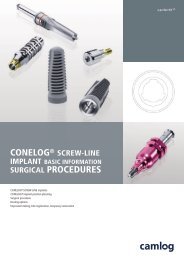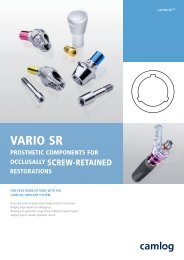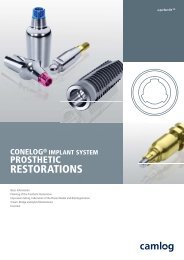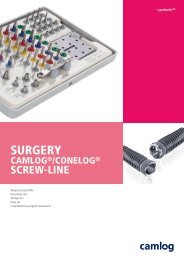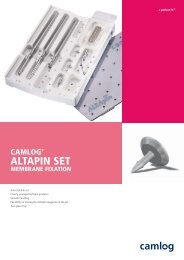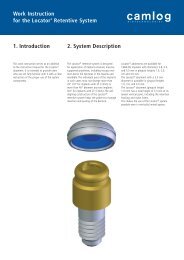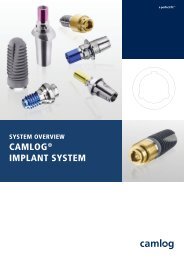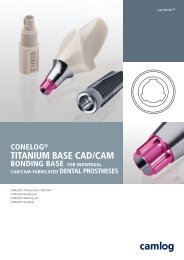Hybrid Restorations with the CAMLOG Implant System (PDF
Hybrid Restorations with the CAMLOG Implant System (PDF
Hybrid Restorations with the CAMLOG Implant System (PDF
You also want an ePaper? Increase the reach of your titles
YUMPU automatically turns print PDFs into web optimized ePapers that Google loves.
HYBRID RESTORATIONS WITH THE <strong>CAMLOG</strong> ® IMPLANT SYSTEM<br />
DOUBLE CROWN<br />
RESTORATIONS<br />
PROCESSING THE <strong>CAMLOG</strong> ® ABUTMENTS<br />
EXAMPLE OF THE <strong>CAMLOG</strong> ® UNIVERSAL ABUTMENT<br />
After fabricating <strong>the</strong> cast, <strong>the</strong> <strong>CAMLOG</strong> ® universal abutments are inserted<br />
into <strong>the</strong> <strong>CAMLOG</strong> ® lab analogs and fixed <strong>with</strong> <strong>the</strong> <strong>CAMLOG</strong> ® lab screw.<br />
A previously prepared silicone index is used to mark <strong>the</strong> height and axis<br />
alignments.<br />
The height of <strong>the</strong> abutments is first adjusted. The height of <strong>the</strong> circular functional<br />
surface must not fall below 5 mm, o<strong>the</strong>rwise sufficient retention<br />
strength of <strong>the</strong> construction cannot be achieved. The uniform insertion<br />
direction is <strong>the</strong>n determined and <strong>the</strong> abutments are machined <strong>with</strong> suitable<br />
abrasives in <strong>the</strong> parallelometer. The specified speeds of each abrasive used<br />
for titanium machining must be observed.<br />
Overheating <strong>the</strong> titanium leads to a very hard surface (alpha case layer) and<br />
should be avoided.<br />
For fabrication of double crowns using <strong>the</strong> electroplating technique, <strong>the</strong><br />
manufacturer's specifications must be observed. Cast fabrication of double<br />
crowns are prepared similar to <strong>the</strong> cone telescopic crown technique. To prevent<br />
<strong>the</strong> caps from rotating, <strong>the</strong> abutments are lightly ground in oval form.<br />
The surface must be homogeneous.<br />
66<br />
The space for <strong>the</strong> tertiary framework required to receive <strong>the</strong> secondary<br />
crowns can be tested at every phase of preparation <strong>with</strong> <strong>the</strong> silicone index<br />
<strong>with</strong> <strong>the</strong> denture teeth in position.<br />
Check of <strong>the</strong> space conditions <strong>with</strong> <strong>the</strong> silicone index on <strong>the</strong> working cast<br />
FABRICATING THE SECONDARY CROWNS<br />
The secondary crowns or superstructure are <strong>the</strong>n fabricated. The tensionfree<br />
seat of <strong>the</strong> superstructure is of paramount importance for <strong>the</strong> longterm<br />
success of an implant-pros<strong>the</strong>tic restoration. We recommend bonding<br />
<strong>the</strong> secondary copings intraorally in <strong>the</strong> tertiary framework (passive fit).<br />
NOTES<br />
Electroformed secondary copings<br />
Electroforming is conducted as specified by <strong>the</strong> manufacturer. The<br />
<strong>CAMLOG</strong> ® abutments are inserted into a <strong>CAMLOG</strong> ® lab analog of <strong>the</strong><br />
appropriate diameter and fixed <strong>with</strong> a <strong>CAMLOG</strong> ® lab screw. The thickness<br />
should be 0.2–0.3 mm. The special feature of <strong>the</strong> low layer thickness<br />
of <strong>the</strong> electroformed components and <strong>the</strong> resulting low stability of<br />
<strong>the</strong> secondary coping prevent direct polymerization in <strong>the</strong> acrylic<br />
denture base. For this reason, a tertiary framework must be fabricated<br />
over <strong>the</strong> secondary copings for reinforcement.<br />
Cast secondary copings<br />
The wall thickness of <strong>the</strong> secondary copings should be approx. 0.5 mm.<br />
Fabrication is similar to standard crown and bridge technique.<br />
CAUTION<br />
Do not mix up <strong>the</strong> <strong>CAMLOG</strong> ® abutments and secondary copings! We<br />
recommend a color buccal marker on <strong>the</strong> abutment, coping and working<br />
cast.




